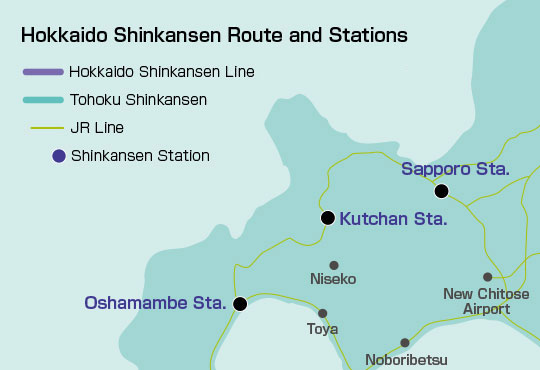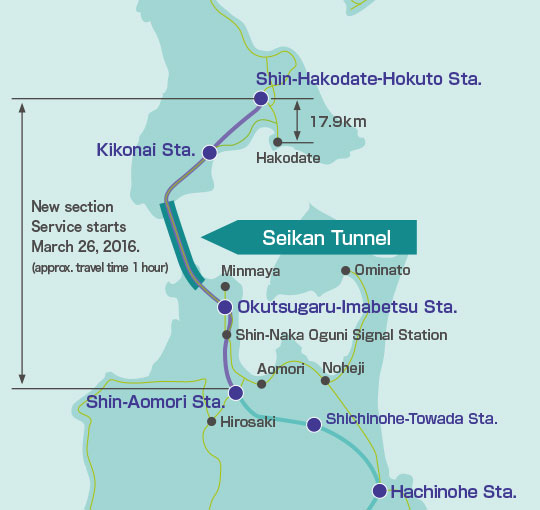As of Saturday, Hokkaido, Japan's northernmost island, was connected to Tokyo by the newest addition to Japan's iconic Shinkansen bullet trains. The 513-mile route includes 33.4 miles in "the world's deepest operational main-line rail tunnel."
"It was last Saturday, at a precise 6.35am, that a sleek new bullet train glided out of Hakodate en route for Tokyo – marking the official launch of an extension of the nation’s famed high-speed rail network to Hokkaido island for the first time," writes The Telegraph's Japan expert, Danielle Demetriou.



Credit: Hokkaido Railway Company
Note: Travel times are for connector train going north from Hakodate, terminal for the new Hakodate-to-Tokyo Shinkansen line. "It’s another approximately 20 minutes by a connector train into Hakodate proper," writes Forbes' business travel blogger, Andrew Bender. An extension to the island's largest metropolis, Sapporo, a familiar name for beer-drinkers, is scheduled to be built by 2030.
According to The Japan Times, "(t)he train uses the undersea Seikan Tunnel linking Hokkaido with Aomori" on the main island of Honshu.
The tunnel opened in 1988 and until recently was used by overnight train services. The line through the tunnel is also shared with local trains.
"And so it was with a regional sigh of relief that the new bullet train extension finally opened last week – slashing the 539 mile Hakodate-Tokyo journey from five-and-a-half hours to four hours two minutes, at its fastest," notes Demetriou.
lt would be an understatement to write that people were excited, or that the train is a great symbol of pride for the Japanese people. "Tickets for the very first bullet train sold out in a suitably high speed 25 seconds when they went on sale last month," writes Demetriou.
According to Reuters, "Japanese media reported that over 500 people gathered to see the first Hokkaido Shinkansen leave the station early in the morning on Saturday." "The futuristic, needle-nosed 10-car trains can seat up to 731 passengers in three classes of service," notes Bender.
"Travel times would be shorter were it not for speed restrictions in the tunnel under the strait between Hokkaido and Honshu," writes Bender, restricting speed to 160 miles per hour.
While competitive with flying (about $40 cheaper), it's not as fast. Even "after allowing time for check-in, security and travel time to and from the city centers," flying is about 40 minutes faster, notes Bender.
FULL STORY: Japan's bullet train reaches Hokkaido — Mar 30

Planetizen Federal Action Tracker
A weekly monitor of how Trump’s orders and actions are impacting planners and planning in America.

Chicago’s Ghost Rails
Just beneath the surface of the modern city lie the remnants of its expansive early 20th-century streetcar system.

Amtrak Cutting Jobs, Funding to High-Speed Rail
The agency plans to cut 10 percent of its workforce and has confirmed it will not fund new high-speed rail projects.

Ohio Forces Data Centers to Prepay for Power
Utilities are calling on states to hold data center operators responsible for new energy demands to prevent leaving consumers on the hook for their bills.

MARTA CEO Steps Down Amid Citizenship Concerns
MARTA’s board announced Thursday that its chief, who is from Canada, is resigning due to questions about his immigration status.

Silicon Valley ‘Bike Superhighway’ Awarded $14M State Grant
A Caltrans grant brings the 10-mile Central Bikeway project connecting Santa Clara and East San Jose closer to fruition.
Urban Design for Planners 1: Software Tools
This six-course series explores essential urban design concepts using open source software and equips planners with the tools they need to participate fully in the urban design process.
Planning for Universal Design
Learn the tools for implementing Universal Design in planning regulations.
Caltrans
City of Fort Worth
Mpact (founded as Rail~Volution)
City of Camden Redevelopment Agency
City of Astoria
City of Portland
City of Laramie





























